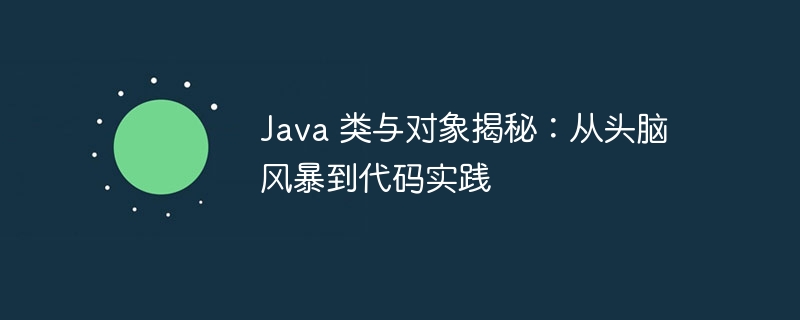Home >Java >javaTutorial >Java classes and objects revealed: from brainstorming to code practice
Java classes and objects revealed: from brainstorming to code practice
- WBOYWBOYWBOYWBOYWBOYWBOYWBOYWBOYWBOYWBOYWBOYWBOYWBforward
- 2024-03-11 09:10:32835browse

Java classes and objects have always been important concepts in programming, which may be confusing for beginners. This article is carefully compiled by PHP editor Shinichi, who will lead you to an in-depth discussion of the relevant knowledge of classes and objects in Java, from theory to practice, allowing you to easily master this important topic. Let's go from brainstorming to code practice together to reveal the secrets of Java classes and objects!
A Java class is a blueprint that describes a group of objects with similar properties and behavior. It defines the object's state (data) and behavior (methods). The class itself does not contain any data or behavior, it is just a template for the object.
Create class
Create a class using the class keyword. The syntax of the class is as follows:
public class MyClass {
// 类成员(数据和方法)
}
Object: instance of class
The object is a specific instance of the class. It contains the actual value of the data and can execute the methods defined by the class.
Create object
Use the new operator to create objects. The syntax is as follows:
MyClass myObject = new MyClass();
Demo code:
public class Person {
private String name;
private int age;
public Person(String name, int age) {
this.name = name;
this.age = age;
}
public String getName() {
return name;
}
public void setName(String name) {
this.name = name;
}
public int getAge() {
return age;
}
public void setAge(int age) {
this.age = age;
}
}
public class Main {
public static void main(String[] args) {
// 创建一个 Person 对象
Person john = new Person("John", 30);
// 访问对象的属性
System.out.println("Name: " + john.getName());
System.out.println("Age: " + john.getAge());
// 修改对象的属性
john.setName("John Smith");
john.setAge(31);
// 再次访问对象的属性
System.out.println("Updated name: " + john.getName());
System.out.println("Updated age: " + john.getAge());
}
}
Encapsulation: hidden implementation
The encapsulation principle hides the internal state and behavior of the object and exposes only the necessary methods and properties. This helps to keep the internal structure of the object from outside interference and enhances the security of the code.
Demo code:
public class BankAccount {
private double balance;
public void deposit(double amount) {
balance += amount;
}
public void withdraw(double amount) {
if (balance >= amount) {
balance -= amount;
} else {
throw new RuntimeException("Insufficient funds");
}
}
public double getBalance() {
return balance;
}
}
Inheritance: Code Reuse
Inheritance allows one class (derived class) to inherit data and methods from another class (base class). Through inheritance, derived classes can reuse code in the base class and add their own unique functionality.
Demo code:
public class Employee extends Person {
private double salary;
public Employee(String name, int age, double salary) {
super(name, age);
this.salary = salary;
}
public double getSalary() {
return salary;
}
public void setSalary(double salary) {
this.salary = salary;
}
}
Polymorphism: multiple uses
Polymorphism allows objects to respond to the same call in different ways. This makes the code more flexible and extensible because objects can be easily replaced or added without modifying the client code.
Demo code:
public interface Animal {
void makeSound();
}
public class Dog implements Animal {
@Override
public void makeSound() {
System.out.println("Woof!");
}
}
public class Cat implements Animal {
@Override
public void makeSound() {
System.out.println("Meow!");
}
}
public class Main {
public static void main(String[] args) {
Animal[] animals = {new Dog(), new Cat()};
for (Animal animal : animals) {
animal.makeSound();
}
}
}
in conclusion
Java classes and objects are the basic concepts of Java Programming. Understanding their relationships and characteristics is critical to building robust, maintainable applications. Through principles such as encapsulation, inheritance, and polymorphism, we can design flexible, reusable code. Mastering these concepts will make you a more proficient Java developer.
The above is the detailed content of Java classes and objects revealed: from brainstorming to code practice. For more information, please follow other related articles on the PHP Chinese website!

